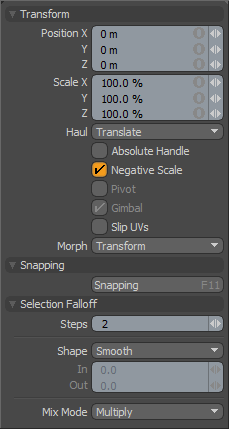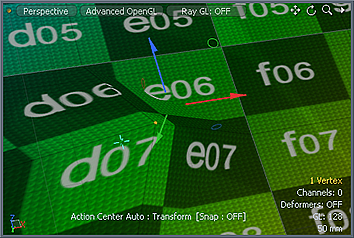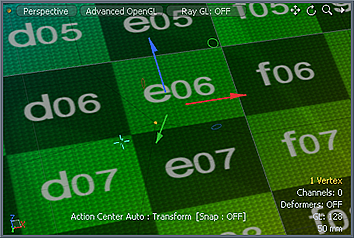Flex
The Flex tool leverages the Selection Border action center and a selection-based falloff. Modo combines these with the standard Transform tool to create a tool that provides a more natural, organic bending-type deformation.

Using the Flex tool
You can find the tool in the Model layout's Deform sub-tab, or in the menu bar, under Edit > Deform > Flex Tool.
| 1. | In the 3D viewport, select the elements you want to deform. |
| 2. | Click the Flex button, or press Shift+Y on the keyboard to activate the tool. |
The standard transform widget appears in the 3D viewport, and you can directly manipulate the currently-selected elements with Move, Rotate, and Scale transforms.
Tip: If you use Flex with the Select Closed Loop command, you can pose meshes in a simple way.
Modo applies the amount of transform to the selection based on the Steps value. With the default value of 2, Modo creates a smooth falloff starting at the boundary of the selection.
The tool's Properties panel includes direct numeric input of all transform values, as well as a Haul list to determine the hauling action, an Absolute Handle checkbox, a Negative Scale checkbox, and options for controlling the Selection falloff.

The following options are available for the Flex tool:
|
Transform |
||||
|---|---|---|---|---|
|
Position X/Y/Z |
Displays the current offset distance. When adjusting an object interactively in the viewport, use these values as feedback for moving the element. You may specify the X, Y, and Z values to apply a specific offset distance (based on the object's position when you activated the tool). |
|||
|
Scale X/Y/Z |
Applies specific scaling values. When adjusting an object interactively in the viewport, the Scale values display the current scale factor applied as feedback for scaling the element. |
|||
|
Haul |
Determines how Modo interprets dragging actions in a viewport (when not using a tool's handles). You have three options available: Translate (the default, to move the selection), Rotate (to rotate the selection), and Scale (to re-size the selection). |
|||
|
Absolute Handle |
When enabled, applies an additional function to the tool handles for you to scale the handle, itself, without affecting the transform amount. In some cases this provides finer control over very large or very small adjustments. |
|||
|
Negative Scale |
When enabled, applies negative scale values, if appropriate, when you manipulate the tool handles in the viewport. When disabled, Modo does not automatically change the values if they are negative. You can always input negative values directly. |
|||
|
Position Only |
(Only available in Items mode) When enabled, only changes the position of the selected items; the orientaion is left unchanged. |
|||
|
Pivot |
Disabled for the Flex tool. |
|||
|
Gimbal |
Disabled for the Flex tool. |
|||
|
Child Compensate |
(Only available in Items mode) When enabled, ignores any transform values for child items. When disabled, passes along transform values to any child items of the current selection. |
|||
|
Slip UVs |
(Only available in Component modes) When enabled, edits applied to the geometry do not change the existing UV map. UV values are generally fixed to specific vertices; therefore, further edits to the geometry may warp, deform, or otherwise distort the UV values in undesirable ways. When this happens, you may need to adjust the map or to redo it altogether. To avoid this undesirable result, you enable Slip UVs so as to not disturb any existing UV mapping applied to the geometry.
|
|||
|
Morph |
(Only available in Component modes) Determines how Modo treats stored morphing information when applying transforms (such as the Move, Rotate, or Scale transforms) to geometry. There are three options for controlling how Modo deals with the morph map vertex data when applying any transforms. • None - Transforms selected (visible) morphs independent of their source, but does not affect unselected morph data. • Transform - Transforms morph data along with the base mesh. • Keep Positions - Converts morph data into an absolute morph map. All vertices retain their pre-transformed positions. Note: In previous versions of Modo, to transform a morph along with its base, you needed to select it in the Vertex Map list. If you didn't, when Modo recalled the relative morph map data, it would produce distorted, undesirable results; therefore, it was easy to accidentally spoil a model. To remedy this problem, current versions of Modo have three options to deal with the morph map vertex data. |
|||
|
Snapping |
See the Applying Snapping topic for details about this feature. |
|||
|
Selection Falloff |
||||
|
Steps |
Determines the extent of the falloff range in that each step represents a loop of polygons or a ring of edge sections. The larger the Steps value, the further the falloff attenuates. |
|||
|
Shape |
Controls the strength of the falloff's influence along the extent by using a shape preset. • Linear - Attenuates the falloff evenly across its range.
• Ease-In - Strengthens the falloff toward the start position.
• Ease-Out - Strengthens the falloff toward the end position.
• Smooth - Strengthens the falloff toward the center of the falloff.
• Custom - Fine tunes the strength of the falloff based on the In and Out values. |
|||
|
In/Out |
Determines the strength of the falloff nearer to the start or end position. |
|||
|
Mix Mode |
Defines how each falloff interacts with the other(s) in instances where there are multiple falloffs applied to a transform (by using Add in the Falloff menu). |
|||


